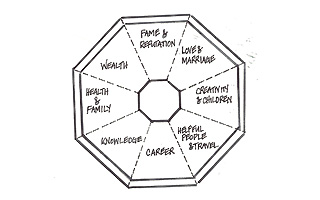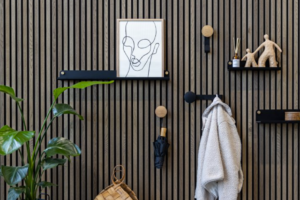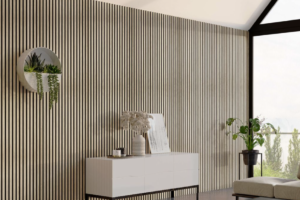 As an interior designer, I know how deeply our outer environments reflect our inner psyche and affect our attitude and actions on a daily basis. Our home, workspace, and even our car’s interior condition often reflect our stress levels, workloads, and general sense of happiness. It’s why I bemoan the cluttered home and emphasize the importance of a calm, orderly living environment — the whole “outer order, inner calm” concept. Feng Shui, an ancient Chinese philosophy, takes this belief one step further by instructing us how to make specific changes in our home to directly influence our health, relationships, love life, creativity, and good fortune. In short, if you move your desk to a different corner and hang a mirror in the right place, you just might get that raise you’ve been gunning for. Sounds like something you’ve seen on HGTV, right? It’s actually an art form that has been in practice for over 3000 years.
As an interior designer, I know how deeply our outer environments reflect our inner psyche and affect our attitude and actions on a daily basis. Our home, workspace, and even our car’s interior condition often reflect our stress levels, workloads, and general sense of happiness. It’s why I bemoan the cluttered home and emphasize the importance of a calm, orderly living environment — the whole “outer order, inner calm” concept. Feng Shui, an ancient Chinese philosophy, takes this belief one step further by instructing us how to make specific changes in our home to directly influence our health, relationships, love life, creativity, and good fortune. In short, if you move your desk to a different corner and hang a mirror in the right place, you just might get that raise you’ve been gunning for. Sounds like something you’ve seen on HGTV, right? It’s actually an art form that has been in practice for over 3000 years.
A Tarot reader can help people to understand the challenges and blocks they may be having in their life and give them a clear direction move one and heal. A tarot card reader can be empowering you and help you create everything you desire but in a different and easier way, they can help you change the way you do hings so you can get better results.
What is Feng Shui?
The origins of Feng Shui (pronounced Fung Shway) trace back to determining the sites for ancient temples, tombs, and palaces in China. The first masters of Feng Shui believed they could determine the most auspicious sites for these monuments by orienting and aligning them with mountains, large bodies of water, the sun and constellations. The invention of the magnetic compass shifted the science’s focus to orienting sites with an emphasis on North-South-East-West.
The Bagua (pronounced Bog-Wah) is the map used in Feng Shui to relate each area in your home to its corresponding element in your personal life; namely your Career, Spirituality, Family, Good Fortune, Fame, Relationships, Children, and Helpful People or friends. As the practice spread to different continents over the centuries, various schools of Feng Shui evolved. Each offers a different method for aligning the Bagua with your home, including one that eschews the compass and is based solely on where you enter a building. For the purposes of this article, I will be using this method of placement, known as the “Form School” of Feng Shui.
Why should we pay attention to Feng Shui?
The literal translation of the word Feng Shui is “wind-water.” This positive relationship between these elements is associated with good health in Chinese Culture, and the practice of Feng Shui is intended to balance the energy, or “chi,” in a space in order to improve its inhabitants’ overall well-being.
We all want our homes to not only look good, but to feel good as well. While part of “feeling” good in a room is a result of comfortable furniture and luxurious fabrics, much of it comes from something else, something intangible and difficult to identify. Reminders of cherished moments, well-earned awards, and family heirlooms all help to bring positive energy to a room. Feng Shui encourages the placement of these objects in specific spots in your home and introduces additional elements we can incorporate to further enhance our sense of well-being and encourage good things to happen in our lives. If placing a plant in the proper corner might bring us more good fortune, who isn’t game to try?
How can we use Feng Shui?
Masters of Feng Shui spend a lifetime studying the art, and I cannot begin to compare my knowledge on the subject to their expertise. It is an entirely separate field of study. However, the more I learn about the art, the more I discover how intertwined it can be with Interior Design and just how frequently it comes up in my work. I approach Feng Shui from the most elementary level.
The first step to practicing Feng Shui is to identify which areas of your home correspond with areas of your personal life. Lay the Bagua over the floorplan or layout of your home, placing the Career area at the entrance. You can now see which areas of the Bagua align with the various rooms in your house.
The most basic principals found in every school of Feng Shui are: De-clutter, Clean, and Cure. Feng Shui teaches that it is critical to de-clutter first; you need to create plenty of space for positive energy to enter your home and for new ideas to grow. When you select the area you’d like to focus on, make sure table or countertops, such as those natural stone countertops, are clear. Clean out drawers and cabinets and eliminate anything in the area that isn’t being used on a regular basis. Then clean the space so it shines — dust and vacuum behind the furniture, make the windows sparkle, shake out the area rug. Only when the space has been cleared out and cleaned, can you begin to focus on applying “cures” to activate positive energy.
There are several common cures or remedies used in Feng Shui: mirrors, plants, water, crystals, and light are all used to amplify positive energy and eliminate negative energy. Incorporating these cures shouldn’t stand out in your home, but should work with your existing design style. In my next article, I’ll focus on how to use these cures in specific areas of your home, like your area of Good Fortune, to attract and stimulate positive energy without detracting from your décor. ©
When you decide to get your garage door serviced, you must ensure that the company you hire has years of experience in dealing with garage doors, Visit Website to check out Lewis River Doors garage door services.
Kitty Burruss is an interior designer living and working in Briarcliff Manor. She currently works for Barbara Sternau Interior Design. 914-631-1875 www.BarbaraSternau.com







